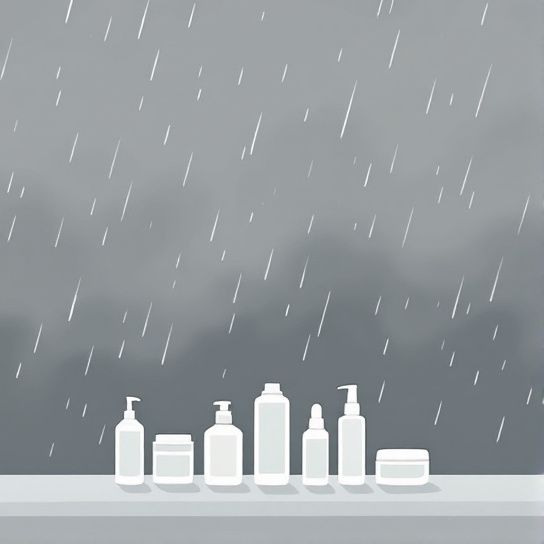Hey there, fellow coastal wanderer! So, you’re noticing that fabulous salty breeze might be causing your skin to act up a bit? Yeah, the struggle of enjoying the perks of living oceanside while battling what I’d coin “climate acne.” Don’t worry, you’re in good company, and we’re here to have a little chat about how you can keep your skin as breezy as your surroundings.
Living near the coast is like hanging out on the permanent edge of paradise. Sun, surf, sand—what’s not to love? Yet, with all these perks come a couple of sneaky little challenges, like how the humid, salty air tends to have its own ideas about what’s best for your skin. And sometimes, those ideas manifest as pesky acne troubles. Worry not; there’s plenty we can do about it.
Understanding Climate Acne
First, let’s dive into what this “climate acne” term is all about. Simply put, climate acne is skin trouble shaped by the environment you’re living in—in this case, your delightful coastal abode. It’s caused by unique factors like humidity, salt air, and sometimes even the grit from sand blowing around you. Uh-huh, the elements that make coastal living unique can also be the culprits behind your skin’s struggles.
Why Coastal Air Amplifies Acne
Think about it: the salt air is fantastic when you’re donning a beach hat and driving along the shore with your windows down. But that same sea breeze is a two-faced friend. It carries moisture and salt right to your skin, which sounds lovely at first, but it can lead to clogged pores. Excessive humidity can also encourage your skin to produce more oil. More oil. More blockages. More acne. See how it checks out?
Humidity and Salt: The Sneaky Duo
Here’s a little tidbit: humidity and salt are like the James Bond villains of coastal living. The humidity wants to super-hydrate but overstays its welcome and turns into oily chaos. Salt, on the other hand, can be drying. Dries up the spots so intensely your skin starts producing all the oil to compensate. A vicious cycle, isn’t it? But don’t fret—we’ve got ways to navigate these waters (pun totally intended).
Quenching Your Skin’s Thirst
Now, to manage this coastal-induced skin act, let’s fraternize with our first line of defense—hydration. Maintaining your skin’s moisture balance amid this moist-dry paradox is vital.
Hydrating Correctly
Alright, give this a try: swap out thicker creams for lighter, water-based moisturizers. Not only do they play nice with humid conditions, they steer clear of adding extra oil to the mix. Trust me on this one; once you go lighter in these conditions, you never look back.

Recommended Lightweight Moisturizers
To keep your skin in harmony, opt for non-comedogenic products—fancy science speak for options that don’t clog your pores. Here are a few to get you started:
- Gel moisturizers with aloe vera
- Hyaluronic acid serums
- Non-oily day creams with added SPF
Hydrate from Inside Out
It goes without saying, but you’ll want to double up on water intake. The salt in the air can pull moisture from your skin, so drink enough to keep that balance. Give lemon-infused water a whirl; it’s not only refreshing but boosts your skin’s health from within. Add some mint if you’re feeling fancy—your tastebuds and your skin will thank you.
Shielding Your Skin From the Elements
Protection—another essential category in the great climate acne showdown. We’re trying to recreate quite the protective cocoon for your skin.
Sun Protection – Not Just in Summer
First off, and I cannot stress this enough: sun protection! Sunscreen isn’t just for beach days. You might love basking in the coastal sunshine, but your skin often feels otherwise. Harmful UV rays are always around—yes, even when it’s cloudy! Protecting your skin from the sun helps fend off eventual breakouts as well as premature aging.
Salt Air Protection
Want to head off the salt issues of the coastline patrols from messing with your comfort? Look into sealing in moisture without making the skin greasy. A hydrating serum layered under your sunscreen works wonders.
Select Sunscreen Wisely
Here’s where the real talk rolls in—choosing your sunscreen. Consider these factors:
- Broad spectrum to fight both UVA and UVB rays
- At least SPF 30
- Lightweight, non-comedogenic formulas with no overwhelming fragrances
Reapply throughout the day, especially if you’re spending a lot of time outside. Throw one in your beach bag, another in your car, and have a travel-sized option always at the ready.
Protective Clothing

Layer your skin defenses by wearing wide-brimmed hats, long sleeves, and sunglasses. These tiny adjustments in your attire can deliver major rewards in your skin’s overall happiness.
Mist to the Rescue
So here’s a neat trick when you feel like everything’s getting out of hand: utilize a facial mist throughout the day. It’s a fine line keeping your face hydrated, unsticky, and feeling fresh—and these little lifesavers can pack a serious punch. Face mists can infuse some much-needed calm when it feels like humidity’s intent on sabotaging your face.
Gentle Cleansing Rituals for Coastal Dwellers
Closing the day, cleansing becomes sacred. By dusk, your skin’s been tangoed by salt, wind, sun, and maybe pollutants. It’s now time to strip without guilt.
Identify Your Enemy – Your Cleanser
Choose your weapon—a gentle cleanser. Heavy, stripping cleaners should be nowhere near your skin amidst coastal living’s unique drumbeats. Mild, fragrance-free gels or foam cleansers are golden.
Step-by-Step Coastal Cleansing
- Rinse with Lukewarm Water: Too hot or too cold just won’t do.
- Apply Your Cleanser: Small amount, gentle motions. Picture a ballet, not a boxing match.
- Circular Rinsing Motion: Removes impurities and reminds you of tidy sandy spirals around seashells.
- Gently Pat Dry: Towels are for blotting, not beach blankets to rub against your skin.
- 5. **Follow Up: Layer your lighter moisturizer immediately to lock in hydration post cleanse.
Special Skincare Treatments for Climate Acne
Finally, the good bits of treatment to help when the breakout beasts show up as unwanted parties.
When to Exfoliate
A word of advice: exfoliate selectively. Once or twice a week, max. Physical scrubs are somewhat discouraged—instead, understand chemical exfoliants, such as AHAs or BHAs, much gentler in this environment.
Nurture with Natural Solutions
Switch out harsh products for natural options where you can. Natural products suit environmental skin concerns born from atmospheric melee. Aloe, green tea, chamomile—top gun against irritation.

Products Targeting Climate Acne
Looking for more specific care? Acne treatments with natural actives like tea tree oil or salicylic acid will help unclog pores and behave kindly to your unique needs.
Making Comps & Lifestyle Adjustments
Well, my fellow coastal denizen, climate acne isn’t just about laughter lines crossing with frowns. Mostly, it takes up space from differing routines and a little bit of faith in mastering at-ons regulation. Let’s blend everything perfectly by adding those extra adjustments to your cheeky lifestyle.
Connection Between Diet, Sleep, and Skin
Nothing is more ocean-esque than flowing harmonies, right? Find the truest skin reward when aligning simple wellness chunks together: sound eats, heavenly sleeps, moving water bodies.
Embrace Anti-inflammatory Diet
Nourish your beach swept self gently by appreciating an ocean shaft diet: berries, omega-rich fish straight from waters you adore.
- Fruits and Veggies: Like a dolphin playing among coral, quick bursts keep skin smooth.
- Healthy Fats: Maybe those salmon swirls deserved the snorkel dance after all.
- Whole Grains: Becoming yourself lived bravely, whole-r ending those tired white ideas.
Catch More ZZZ’s
Prioritize rest amidst the habitat excitement. Stress leeching breaks into skin anxiety translating often to blemished murmurs loud against blue sky dawns. Remember: tidy sleep fortifies, plainly revitalizes skincare fundamentals. Get there gently!
Reflect, Sail, Shine: Navigating Coastal Living
And that’s the journey! Inhale salty sweetness, and exhale those stress shadows. In this coastal ballet of sand-soft skies, the sea loves your trust. Playfully indulge in what you love while giving that glowing skin its duet.
We’ve journeyed through deterrents and mediations, tuned strategies that dolphins whisper over tidal swings, surfed intricate waters proficiently. It turns out—climate acne isn’t just stone on stone. When managing happily aimed gestures, untangling its webs mustered as stories composed in salt leaps at its floating best.
The splashy canvas hugs you with secrets known only to fellow coastlines. A touch present, inviting, the way buds budge open past gloomy nights, and praying just before sunshine calms salty all-knowing tunes, enchanting for habitats full of song. Poised or fluid, your relations warmly fit coastal ballroom floors.
Live it, love it, let your skin relish in what you’ve architected here today. It’s personal invitations. Coast a little brighter, thrive even higher. Your glow edges the sail—navigate onward and keep sk-intact sailing!
Frequently Asked Questions
How does climate change affect acne?
Climate change can exacerbate acne through several mechanisms. Warmer temperatures and increased UV radiation can stimulate the growth of *Cutibacterium acnes*, a bacteria associated with acne. Additionally, changes in temperature and humidity can increase sebum levels and pilosebaceous unit swelling, leading to hyperplasia of sebaceous glands and promoting acne flares[2][3].
What environmental factors contribute to climate-related acne?
Environmental factors such as air pollution, temperature fluctuations, humidity, and increased UV radiation play significant roles in climate-related acne. Air pollution can lead to oxidative stress and skin damage, while high temperatures and humidity can increase sebum production and create an environment conducive to acne-causing bacteria[1][2][3].
How do seasonal changes impact acne?
Seasonal changes can significantly impact acne. During winter, dry air can lead to increased sebum production and flaky skin, making acne worse. In contrast, humid air during warmer seasons can trap oil on the skin’s surface, creating an environment where acne-causing bacteria thrive. Adjusting skincare routines according to the season can help manage these effects[4][5].
What skincare practices can help mitigate climate-related acne?
To mitigate climate-related acne, it is important to maintain a consistent skincare routine. This includes using gentle cleansers, non-comedogenic moisturizers, and sunscreen with SPF 30 or higher. Adjusting your routine to the current season, such as using hydrating products in dry weather and oil-controlling products in humid weather, can also be beneficial[1][4][5].
References










